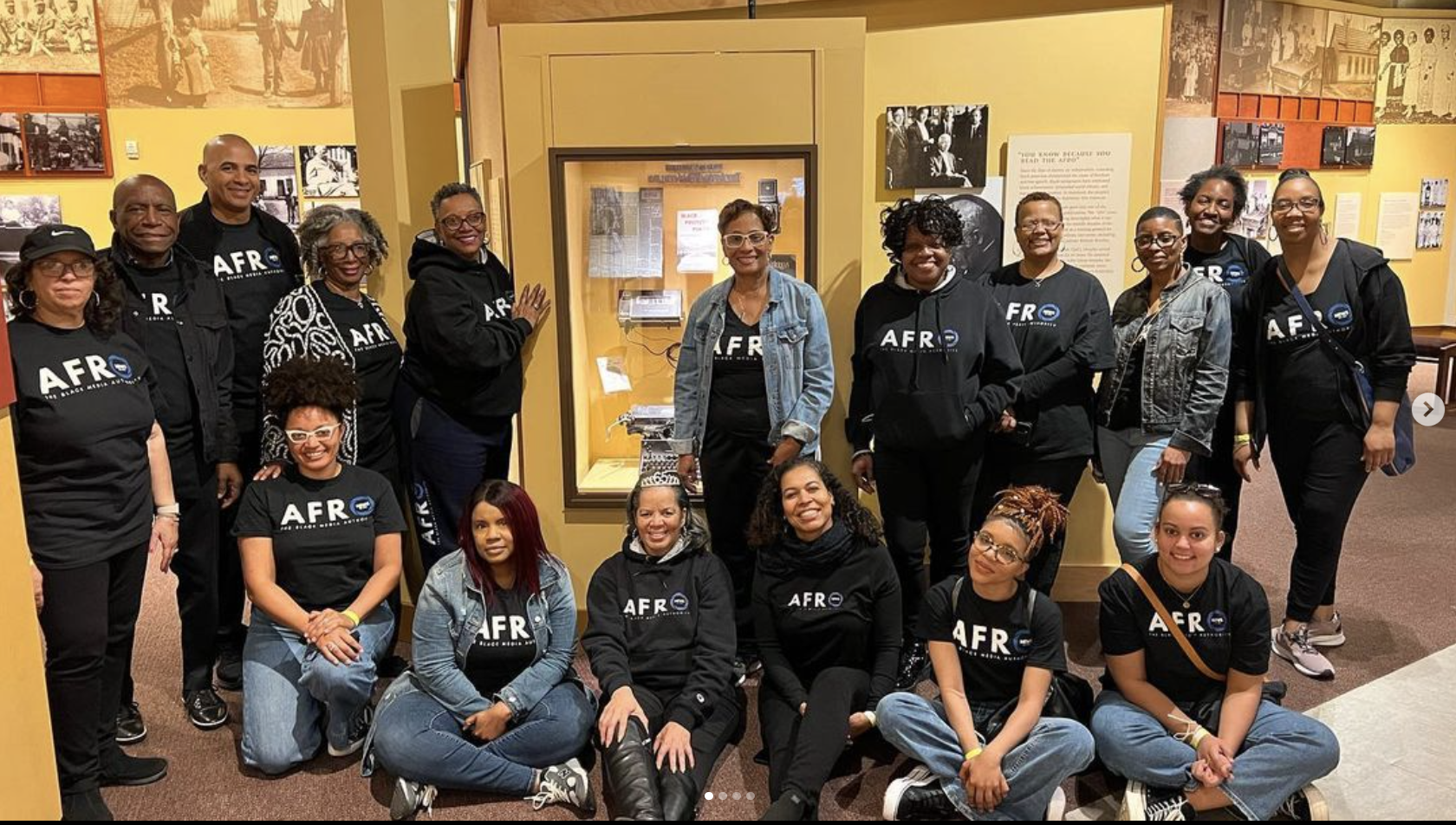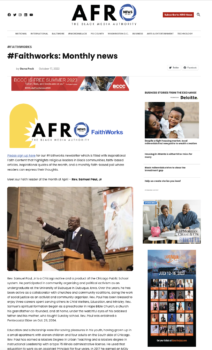How the AFRO uses social media, newsletters and texting to engage with faith communities
Dana Peck, The AFRO,
The AFRO staff pictured together at a team outing (Courtesy of The AFRO staff)
Here’s an idea to steal and adapt: If you want to easily gauge your audience and facilitate immediate responses and manage your relationship with your audience, use a two-way text messaging program.This is a series on Better News to a) showcase innovative/experimental ideas that emerge from the Knight-Lenfest Newsroom Initiative and b) share replicable tactics that benefit the news industry as a whole. This “win” comes from Dana Peck, director of digital solutions at the AFRO, which participated in the Poynter Table Stakes program in 2022.
Question: What communities do you serve and what can you tell us about the history of your organization?
Answer: The AFRO primarily serves the African American populations in Baltimore, Md.; Washington, D.C.; and surrounding metropolitan areas.
Our social media followers and viewers are defined as ages 18-65+, mostly from the following five U.S. markets – Baltimore, Washington, New York, Chicago and Atlanta – with an equal split between males and females. We have a local news focus in the District of Columbia, Maryland and Virginia region (DMV) but intentionally report on national and international news of interest to our readers
Q: What problem were you trying to solve, and why was solving the problem strategically important for your organization?
A: As the longest-running African American, family-owned newspaper business in the nation, the AFRO leverages AFRO.com and our social media platforms to provide readers with good news about our community not otherwise found in other news outlets.
Our articles take mainstream stories and present them in a way that offers a voice and perspective from the African American lens.
We notice a great void in positive news coverage about our communities and access to credible news sources, which leads to a general distrust of mainstream media sources. We want to continue to provide local and national news coverage without paywalls that are reflective of the communities that we serve.
As part of the Table Stakes program, we specifically wanted to re-engage with the faith community to ultimately increase readership, page views and subscriber revenue. Previously, we produced dedicated faith content like columns and posted faith-based events regularly.
We’ve increased several key metrics, most notably with respect to subscriber revenue. Subscription revenue increased 57% from the prior year, which represents a $29,914 increase in revenue.
The #faithworks newsletter was a new initiative through the program. As of May 2023, 2,860 people signed up for the newsletter. We send the newsletter to our entire database, and we are seeing the highest open rates (38.28%) compared to our other newsletters. We send the newsletter to over 16,000 subscribers.
Q: How is this approach related to Table Stakes (e.g. one of the 7 Table Stakes and/or an outgrowth of the Knight-Lenfest initiative, etc.)?
A: This initiative is related to Table Stake No. 1 (“Serve targeted audiences with targeted content”) and Table Stake No. 2 (“Publish on the platforms used by your targeted audiences).
More specifically, the AFRO has been a beacon of light for the African American community for 130 years, over six generations and counting. We are telling our story with over 100 million photos, stories and online views.
The AFRO continues to be an incubator for Black journalists, photographers and bloggers. While newspapers are fighting to survive, the AFRO American Newspaper finds itself adjusting to the changing times with a big push on our digital presence. Given this background, we seek to become a more audience-focused media company.
Q: What platforms are you using to grow your reach?
A: We use social media platforms (Instagram, Facebook, Linkedin, Twitter). We produce newsletters via ActiveCampaign and Constant Contact. We use Subtext for two-way text messaging. All of this is to grow our reach. We are intentional about leveraging technology.
We repurpose published content from afro.com to all of our social media platforms, newsletters and via text. This strategy includes our #faithworks content. When an editor publishes an article, we may reformat the image associated with that content and add animation and other other images and wording to make it more attractive on social media.

A screenshot of an Instagram post from The AFRO’s account
We are pursuing proof of concept of a news and information delivery system for our target audiences using our existing curated content and relevant daily news. We are creating branded information walls with partners like churches, public transportation sites, convenience stores and/or medical facilities to deliver positive informative content to our audiences where they are.
Q: How do you use technology and data to decide on a strategy?
A: We understand our communities and the tremendous impact we can make. We used Subtext two-way messaging to survey readership and BlueLena with ActiveCampaign to manage reader revenue promotions.
Subtext is used to ask questions of our subscribers, remind them of upcoming events and share our weekly covers. With BlueLena via ActiveCampaign, we create pop-ups to direct readers to donor, subscriber or member options. We also use these platforms to design, send and track our newsletters.
Q: What kind of funding and revenue models are you developing to sustain your business?
A: We are invested in a diversified funding model that includes reader revenue, partnerships, philanthropic efforts, events and grants.
Reader revenue and sponsored content have been growing sources of revenue for us and we expect that growth to continue in the next five years.
The AFRO has also been able to leverage our longtime community connections to develop custom sponsored campaigns focused on health outreach in the African American community.
Team members launched partnerships with Johns Hopkins University and Biogen that were focused on awareness around health issues, and we expect this to also be an area for growth. Our digital out-of-home efforts are also an additional source for advertising revenue.
Sponsored content now makes up 18% of our revenue — a huge growth area in the last five years..
Q: What have you learned about your audience’s interests?
A: We have learned from our previous successes among the faith-based audience that there is great diversity in the audience and many enjoy the faith leader spotlight.
We confirmed that many prioritize prayers and attending services and/or faith events to deepen their faith. We also learned that many members of the community are interested in topics of social justice and advocacy. This can include issues about poverty, hunger, homelessness and education.
Q: Who on your team has helped you with this effort and what is their role in the newsroom?
A: Editorial, digital and administrative teams assist with our efforts.
Q: What advice would you give to others who aim to engage a faith-based audience?
A: News outlets must be creative with reaching out to different faith communities.

A screenshot of The Afro’s monthly Faithworks newsletter
We found success building relationships with faith leaders by interviewing and highlighting them in our newsletters and website. We are intentional about covering faith-related stories and distribute those articles via our newsletters and on our website.
To reach out to the faith community, it’s important to understand their beliefs and values. This can help you create content that resonates with them and avoid topics or language that might be offensive or controversial.
We recommend promoting these articles on social media to further the reach of these topics.
Lastly, we provide opportunities for faith communities to engage via our calendar, directory and submitting faith leaders to be highlighted for the month. Following these tips, media outlets can effectively reach out to the faith community and establish themselves as a trusted source of information.
Q: Is there anything else you’d like to add?
A: The AFRO American Newspapers and AFRO.com are trusted sources that provide readers with good news about the African American community not otherwise found in other news outlets.
Our articles take mainstream stories and present them in a way that offers a voice and perspective through the African American lens. A donor from a recent fundraising campaign echoed the sentiments of many others when she commented, “Thank you for telling our story and spreading GOOD news about African-American achievement.”
Our recent community survey over the summer provided insight into our impact. One reader wrote: “Love the way you report Our news! Sometimes the only place we can get it.”
We utilize this influence to shape the political and social order of our community.
The camaraderie with other media companies and the ability to learn from others during our season with Table Stakes was invaluable.